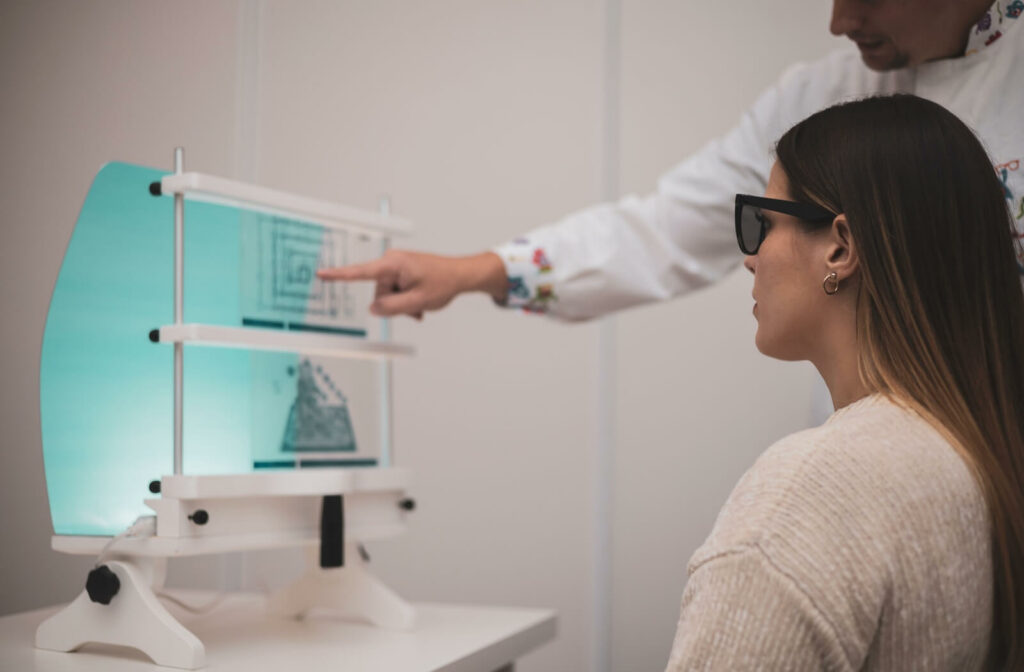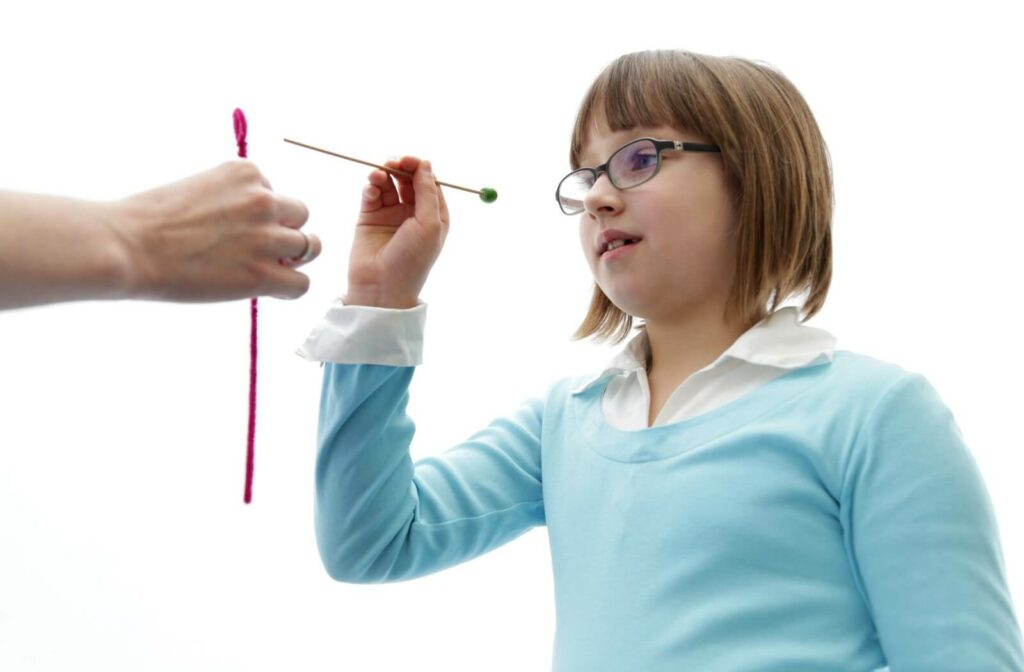Struggles with reading or battling constant headaches after working at a computer are just a couple of things that vision therapy can help with. Vision therapy is an effective, non-invasive treatment that helps people strengthen their visual skills, improving their ability to interpret and respond to visual information.
There isn’t a one-size-fits-all for how long vision therapy takes because each therapy program is tailored to each person’s needs. So, vision therapy may run anywhere from several weeks to 6 months or more.
Your eye doctor can provide a more accurate estimation for you after examining your eyes, discussing the required treatment, and building a custom vision therapy plan to get your brain and eyes working together.
What Is Vision Therapy?
Vision therapy is a customized training program using a set of visual activities to improve the connection between your eyes and brain. Think of it as physical therapy for your visual system. Unlike glasses or contact lenses, which primarily correct vision problems like nearsightedness or farsightedness, vision therapy addresses functional and perceptual issues.
It’s often recommended for those experiencing challenges with visual skills:
- Struggles with reading or learning in school
- Difficulty focusing on nearby objects, particularly with computer screens
- Eye alignment issues such as strabismus (crossed eyes) or lazy eye (amblyopia)
- Poor hand-eye coordination that affects sports performance
- Problems with visual processing or interpretation
Common Vision Problems Addressed by Vision Therapy
Vision therapy can treat a surprising range of conditions, including:
By improving these functional issues, vision therapy empowers people to excel academically, professionally, and athletically.
The Process of Vision Therapy
Effective vision therapy programs are personalized and involve several key stages. Here’s how the process typically unfolds:
Initial Consultation & Assessment
Your first step is an in-depth consultation with a vision specialist. The specialist will typically evaluate your symptoms, medical history, and visual skills during this session.
Expect assessments such as eye alignment tests, eye movements, focus, and depth perception tasks. These evaluations help determine the severity of the problem and form the basis for your custom vision therapy plan.
Developing Your Personalized Therapy Plan
No two vision therapy plans are identical because they are designed to address individual needs. Your therapy may include specialized eye exercises, computer-based activities, and even tools like prisms, lenses, or filters.
The ultimate goal is to enhance your brain’s ability to control visual skills effectively, ensuring lasting improvements rather than temporary fixes.
Average Length of Vision Therapy Appointments
Each vision therapy session typically lasts 30 to 60 minutes. Sessions are held once or twice a week, depending on your needs and availability.
A key component of vision therapy’s success is its hands-on nature. During these appointments, your vision therapist will guide you through activities that strengthen visual skills, correct misalignments, or improve focus and tracking.

Total Length of Vision Therapy Treatment
Vision therapy programs can provide the desired results for some conditions within a few weeks but others might take up to a year or more. Your eye doctor can monitor your progress and provide you with an accurate timeline, adapting the program length as necessary.
Patience is essential. Vision therapy focuses on permanent improvements rather than quick fixes, so the time investment is worth the potentially life-changing results.
What Determines the Overall Length?
Several factors can influence the total duration of vision therapy, including:
- The specific vision issue: Mild issues like eye strain may require only a few weeks, while more complex conditions such as lazy eye or strabismus can take months.
- Age: Children often experience faster results due to their brain’s plasticity, while teenagers and adults may require more time.
- Commitment to home exercises: Completing recommended home exercises regularly can accelerate progress significantly.
- The severity of symptoms: More severe cases naturally require longer therapy to achieve substantial improvement.
Tips for Success in Vision Therapy
Maximize the benefits of vision therapy and help ensure long-term results with these helpful tips:
Follow Through with Home Exercises
Your therapist will often assign exercises designed to reinforce what you’ve worked on during in-office sessions. Think of these as homework for your eyes. Practice them consistently to maintain momentum between appointments.
Build a Routine
Consistency is your best friend—schedule therapy sessions at the same time each week and set reminders for any home exercises.
Communicate with Your Vision Therapist
Stay in close communication with your therapist throughout the program. Share feedback on progress, challenges, and any changes you notice—they’ll use this information to adjust your therapy for optimal results.
Celebrate Small Wins
Improving visual skills takes time, so celebrating small victories—like reading more fluently or catching a ball more reliably—can keep motivation levels high.
Keep Up with Follow-Up Appointments
Once your program ends, periodic follow-ups may be recommended to ensure progress is maintained. These check-ins are invaluable for preventing regression.
Taking the First Step Towards Better Vision
Vision therapy transforms lives—but like any worthwhile endeavour, it takes commitment and patience. Whether your treatment lasts 3 months, 6 months, or a year, the results often include better performance at school, work, and sports.
Call us today to schedule your initial consultation with Milton Vision & Sports Vision Training Centre and discover how our experienced team can help keep your vision clear and your eyes healthy.



